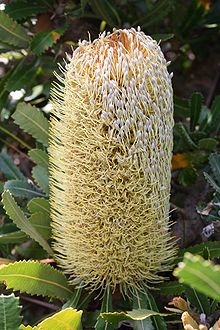Banksia ser. Banksia
| Banksia ser. Banksia | |
|---|---|

| |
| Banksia serrata (saw banksia), the type species of Banksia. | |
| Scientific classification | |
| Kingdom: | Plantae |
| Clade: | Tracheophytes |
| Clade: | Angiosperms |
| Clade: | Eudicots |
| Order: | Proteales |
| Family: | Proteaceae |
| Genus: | Banksia |
| Subgenus: | Banksia subg. Banksia |
| Section: | Banksia sect. Banksia |
| Series: | Banksia ser. Banksia |
| Synonyms | |
|
B. sect. Orthostylis Benth. | |
Banksia ser. Banksia is a valid
According to Bentham
Banksia ser. Banksia originated in 1870 as Banksia sect. Orthostylis. Published by
- Banksia
- B. sect. Oncostylis (13 species)
- B. sect. Cyrtostylis(10 species)
- B. sect. Eubanksia (3 species)
- B. sect. Orthostylis
- B. latifolia (now B. robur)
- B. serrata
- B. ornata
- B. coccinea
- B. sceptrum
- B. menziesii
- B. lævigata
- B. hookeriana
- B. prionotes
- B. victoriæ
- B. speciosa
- B. baxteri
- B. marcescens (now B. praemorsa)
- B. lemanniana
- B. caleyi
- B. lindleyana
- B. elegans
- B. candolleana
- B. sect. Isostylis(1 species)
According to George 1981
In 1981,
The placement and circumscription of B. ser. Orthostylis in George's 1981 arrangement may be summarised as follows:
- Banksia
- B. subg. Banksia
- B. sect. Banksia
- B. ser. Salicinae (9 species)
- B. ser. Grandes (2 species)
- B. ser. Quercinae (3 species)
- B. ser. Orthostylis
- B. ser. Crocinae (4 species)
- B. ser. Cyrtostylis (12 species)
- B. ser. Prostratae (6 species)
- B. ser. Tetragonae (3 species)
- B. ser. Coccineae(1 species)
- B. sect. Oncostylis (3 series, 21 species)
- B. sect. Banksia
- B. subg. Isostylis (2 species)
- B. subg. Banksia
The placement of B. sceptrum (Sceptre Banksia) in this series was initially tentative, as George felt that "in some respects it also shows a relationship to the series Cyrtostylis". B. aemula (Wallum Banksia) was also flagged as anomalous in having a conical pollen-presenter, and B. pilostylis (Marsh Banksia) was noted as the only species outside the series that has a hairy pistil. Overall, George accepted that the resultant series was "somewhat heterogeneous", but argued that the species had enough in common to warrant grouping them together. Since species of B. ser. Orthostylis occur in both western and eastern Australia, George suggested that it had evolved early, and was widespread across southern Australia before aridification and marine incursion established the Nullarbor Plain as a barrier to genetic exchange.[2]
George's 1981 publication of B. ser. Orthostylis was illegal. Since the series contained
According to Thiele and Ladiges
In 1996,
On the basis of this clade, Thiele and Ladiges abandoned B. ser. Crocinae, transferring its four taxa into B. ser. Banksia. They then divided the series into two subseries, placing B. ornata (Desert Banksia), B. serrata and B. aemula in B. subser. Banksia, and all other species in B. subser. Cratistylis.[4]
The placement and circumscription of B. ser. Banksia in Thiele and Ladiges' arrangement may be summarised as follows:[4]
- Banksia
- B. subg. Isostylis (3 species)
- B. elegans (incertae sedis)
- B. subg. Banksia
- B. ser. Tetragonae (4 species)
- B. ser. Lindleyanae(1 species)
- B. ser. Banksia
- B. baueri (incertae sedis)
- B. lullfitzii (incertae sedis)
- B. attenuata (incertae sedis)
- B. ashbyi (incertae sedis)
- B. coccinea (incertae sedis)
- B. ser. Prostratae (8 species)
- B. ser. Cyrtostylis (4 species)
- B. ser. Ochraceae (4 species)
- B. ser. Grandes (2 species)
- B. ser. Salicinae (2 subseries, 11 species, 4 subspecies)
- B. ser. Spicigerae (3 subseries, 7 species, 6 varieties)
- B. ser. Quercinae (2 species)
- B. ser. Dryandroides (1 species)
- B. ser. Abietinae (4 subseries, 14 species, 8 subspecies)
According to George 1999
Thiele and Ladiges' arrangement remained current only until 1999, when George's treatment of the genus for the
Recent developments
Since 1998,
Early in 2007 Mast and Thiele initiated a rearrangement of Banksia by transferring Dryandra into it, and publishing B. subg. Spathulatae for the species having spoon-shaped cotyledons; in this way they also redefined the autonym B. subg. Banksia. All members of B. ser. Banksia fall within Mast and Thiele's B. subg. Banksia, but no more detail has been published. Mast and Thiele have foreshadowed publishing a full arrangement once DNA sampling of Dryandra is complete.[8]
References
- ^ Bentham, George (1870). "CIV. Proteaceae: 29. Banksia". Flora Australiensis. Vol. V: Myoporineae to Proteaceae. London: L. Reeve & Co. pp. 541–562.
- ^ a b George, Alex S. (1981). "The Genus Banksia L.f. (Proteaceae)". Nuytsia. 3 (3): 239–473.
- ^ ISBN 0-643-06454-0.
- ^ .
- doi:10.1071/SB97026.
- PMID 21665734.
- doi:10.1071/SB04015.
- doi:10.1071/SB06016.
External links
- "Banksia ser. Banksia". Flora of Australia Online. Department of the Environment and Heritage, Australian Government.
- "Banksia L.f. ser. Banksia". Australian Plant Name Index (APNI), IBIS database. Centre for Plant Biodiversity Research, Australian Government.
